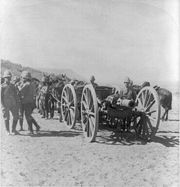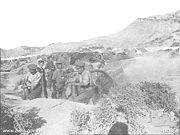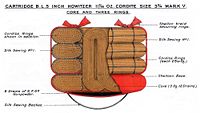
BL 5 inch Howitzer
Encyclopedia
The Ordnance BL 5 inch Howitzer was initially introduced to provide the Royal Field Artillery
with continuing explosive shell capability following the decision to concentrate on shrapnel for field guns in the 1890s.
and served successfully at the Battle of Omdurman
in 1898. During that campaign they gained the distinction of being the first British guns to fire the new lyddite shells in action.
 Major D Hall states that in the Second Boer War
Major D Hall states that in the Second Boer War
the Lyddite shells often failed to detonate; the gun was too heavy to be used as a field howitzer, and for siege use its range was too short and shell too light. However it achieved some success in Natal
when able to get close enough to bombard Boer
s in trenches
.
 By 1908 it was obsolete and replaced in British Regular Army brigades by the modern QF 4.5 inch Howitzer
By 1908 it was obsolete and replaced in British Regular Army brigades by the modern QF 4.5 inch Howitzer
.
Territorial Force
brigades however continued to use the howitzer in World War I
into 1916, including notably in the East African campaign
.
A lighter 40 pound (18.14 kg) shell with Amatol
filling replaced the original 50 pound (22.68 kg) Lyddite shell early in World War I
Together with an increase in cordite propellant from 11oz 7drams to 14oz 5 drams, this increased the maximum range from 4,800 to 6500 yards (5,943.6 m). Administrative error led to the new 40 pound shells being sent to Gallipoli
without range table
s or fuze keys for the new pattern fuzes, rendering them useless.
Royal Field Artillery
The Royal Field Artillery of the British Army provided artillery support for the British Army. It came into being when the Royal Artillery was divided on 1 July 1899, it was reamalgamated back into the Royal Artillery in 1924....
with continuing explosive shell capability following the decision to concentrate on shrapnel for field guns in the 1890s.
Sudan Campaign
The weapon was used by the Royal Field ArtilleryRoyal Field Artillery
The Royal Field Artillery of the British Army provided artillery support for the British Army. It came into being when the Royal Artillery was divided on 1 July 1899, it was reamalgamated back into the Royal Artillery in 1924....
and served successfully at the Battle of Omdurman
Battle of Omdurman
At the Battle of Omdurman , an army commanded by the British Gen. Sir Herbert Kitchener defeated the army of Abdullah al-Taashi, the successor to the self-proclaimed Mahdi Muhammad Ahmad...
in 1898. During that campaign they gained the distinction of being the first British guns to fire the new lyddite shells in action.
Second Boer War

Second Boer War
The Second Boer War was fought from 11 October 1899 until 31 May 1902 between the British Empire and the Afrikaans-speaking Dutch settlers of two independent Boer republics, the South African Republic and the Orange Free State...
the Lyddite shells often failed to detonate; the gun was too heavy to be used as a field howitzer, and for siege use its range was too short and shell too light. However it achieved some success in Natal
Colony of Natal
The Colony of Natal was a British colony in south-eastern Africa. It was proclaimed a British colony on May 4, 1843 after the British government had annexed the Boer Republic of Natalia, and on 31 May 1910 combined with three other colonies to form the Union of South Africa, as one of its...
when able to get close enough to bombard Boer
Boer
Boer is the Dutch and Afrikaans word for farmer, which came to denote the descendants of the Dutch-speaking settlers of the eastern Cape frontier in Southern Africa during the 18th century, as well as those who left the Cape Colony during the 19th century to settle in the Orange Free State,...
s in trenches
Trench warfare
Trench warfare is a form of occupied fighting lines, consisting largely of trenches, in which troops are largely immune to the enemy's small arms fire and are substantially sheltered from artillery...
.
World War I

QF 4.5 inch Howitzer
The Ordnance QF 4.5 inch Howitzer was the standard British Empire field howitzer of the First World War era. It replaced the BL 5 inch Howitzer and equipped some 25% of the field artillery. It entered service in 1910 and remained in service through the interwar period and was last used in...
.
Territorial Force
Territorial Force
The Territorial Force was the volunteer reserve component of the British Army from 1908 to 1920, when it became the Territorial Army.-Origins:...
brigades however continued to use the howitzer in World War I
World War I
World War I , which was predominantly called the World War or the Great War from its occurrence until 1939, and the First World War or World War I thereafter, was a major war centred in Europe that began on 28 July 1914 and lasted until 11 November 1918...
into 1916, including notably in the East African campaign
East African Campaign (World War I)
The East African Campaign was a series of battles and guerrilla actions which started in German East Africa and ultimately affected portions of Mozambique, Northern Rhodesia, British East Africa, Uganda, and the Belgian Congo. The campaign was effectively ended in November 1917...
.
A lighter 40 pound (18.14 kg) shell with Amatol
Amatol
Amatol is a highly explosive material made from a mixture of TNT and ammonium nitrate. Its name originates from the words ammonium and toluene...
filling replaced the original 50 pound (22.68 kg) Lyddite shell early in World War I
World War I
World War I , which was predominantly called the World War or the Great War from its occurrence until 1939, and the First World War or World War I thereafter, was a major war centred in Europe that began on 28 July 1914 and lasted until 11 November 1918...
Together with an increase in cordite propellant from 11oz 7drams to 14oz 5 drams, this increased the maximum range from 4,800 to 6500 yards (5,943.6 m). Administrative error led to the new 40 pound shells being sent to Gallipoli
Battle of Gallipoli
The Gallipoli Campaign, also known as the Dardanelles Campaign or the Battle of Gallipoli, took place at the peninsula of Gallipoli in the Ottoman Empire between 25 April 1915 and 9 January 1916, during the First World War...
without range table
Range table
A range table was a list of angles of elevation a particular artillery gun barrel needed to be set to, to strike a target at a particular distance with a projectile of a particular weight using a propellant cartridge of a particular weight...
s or fuze keys for the new pattern fuzes, rendering them useless.
Ammunition
 |
 |
||
External links
- Great War Diary - German East Africa 1916 - of Sergeant Joseph Daniel Fewster, 1st. (Hull) Heavy Battery R.G.A.
- Bennet Burleigh, Khartoum Campaign, 1898 Describes 5 inch howitzer use in the campaign

